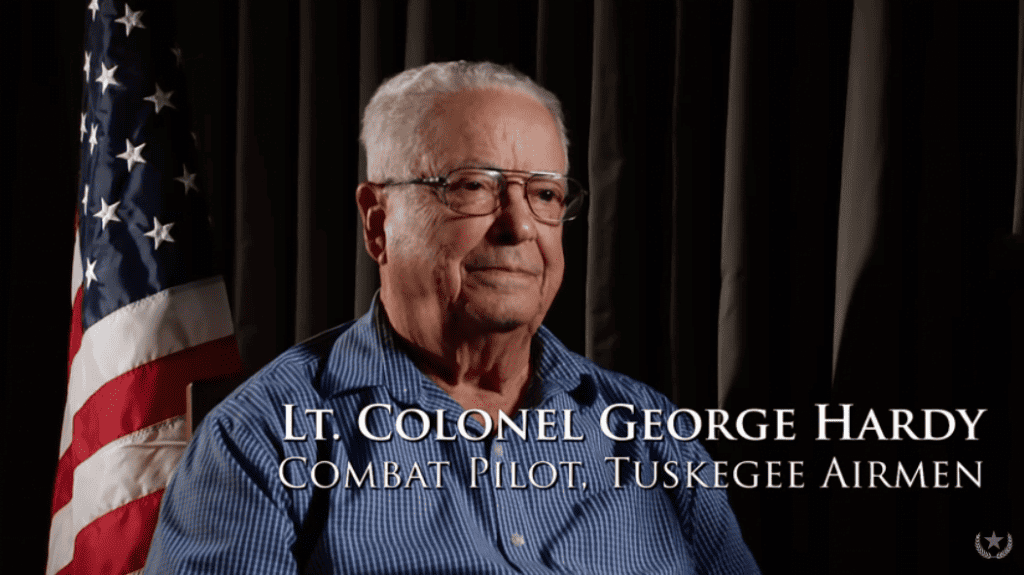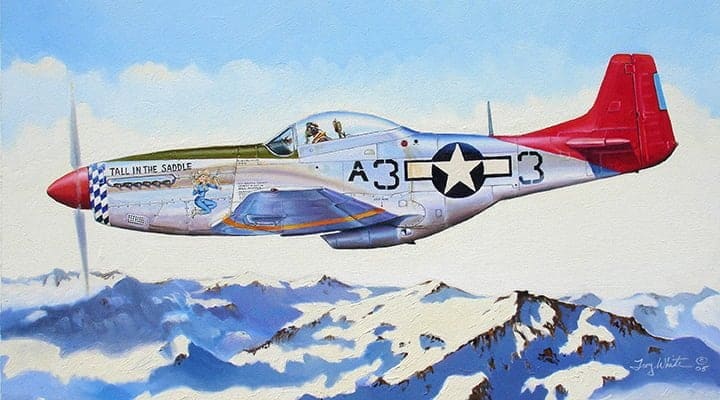 Class 44-H-SE 9/8/1944 2nd Lt. 0838029 Philadelphia, PA
Class 44-H-SE 9/8/1944 2nd Lt. 0838029 Philadelphia, PA
June 8, 1925 –
Unit: 301st Fighter Squadron of the 332nd Fighter Group
Awards: Distinguished Flying Cross, the Air Medal with 11 Oak Leaf Clusters, and the Commendation Medal with one Oak Leaf Cluster, bronze replica of the Congressional Gold Medal
George Hardy entered active duty in July of 1943 at the age of 17. In July 1943 he was called to active duty and sent to Keesler Army Air Field, Biloxi, Mississippi, for basic training. In September 1943 he was assigned to the 320th College Training Detachment at Tuskegee Institute in Alabama. His group was scheduled to take college-level courses, at Tuskegee Institute, for a period of five months. This training was cut short in the beginning of December, as his group was transferred to Tuskegee Army Air Field (TAAF) for Aviation Cadet training, as part of Class 44-H. In September 1944 he graduated as a single-engine pilot and was commissioned a Second Lieutenant in the U.S. Army. In November he was transferred to Walterboro AAF in South Carolina for combat flying training in P-47 aircraft. This combat flying training was completed in early February 1945, and he was shipped overseas to Italy. In Italy, he was assigned to the 99th Fighter Squadron, 332nd Fighter Group, where he flew 21 combat missions over Germany in P-51 aircraft named “Tall in the Saddle” which had originally had belonged to Captain Wendell Lucas. Those missions were mainly high-altitude escort missions of heavy bombers, but many of the missions also included strafing of ground targets. He returned from Italy in August 1945 and served at TAAF, until it closed in the summer of 1946. In July 1946 he was transferred to Lockbourne AAF, Ohio where he was assigned to the 99th Fighter Squadron, flying P-47 aircraft. He was discharged from active duty in November 1946.
He attended New York University, School of Engineering, in the Bronx, from September 1947 to May 1948. He was recalled to active duty at Lockbourne Air Force Base (LAFB), Ohio, in June 1948. He was assigned to the 301st Fighter Squadron, 332nd Fighter Group, flying P-47 aircraft. In September 1948 he was reassigned as a student in the Airborne Electronics Maintenance Officers Course at Keesler AFB, Mississippi. The course of study covered radar and long-range navigational equipment on fighter and bomber aircraft. He graduated in August 1949. In July 1949 the USAF instituted racial integration and personnel at Lockbourne AFB were reassigned to Air Force bases worldwide. After graduation in August 1949, he was transferred to the 19th bomb Group (B-29 Aircraft) on the island of Guam. He was further assigned to the 28th Bomb Squadron as a maintenance officer. His primary job was supervising about 25 airmen in maintenance of electronic equipment on the assigned aircraft. As a pilot he was also required to fly and was assigned as a copilot on a B-29 aircrew. The Korean War started 25 June 1950, and the 19th Bomb Group was transferred to Kadena Air Base, Okinawa. He flew 45 combat missions over Korea in the B-29 aircraft.
In March 1951 he returned to the states and was assigned to 6th Bomb Wing, at Walker AFB in New Mexico, as a maintenance officer. In June 1951 he was transferred to Lowry AFB, Denver, Colorado for seven months training as an Armament Systems maintenance officer, specifically on B-36 aircraft. The B-36 aircraft was the largest aircraft in the Air Force, capable of intercontinental bombing missions without refueling. The armament systems field included not only the electronic navigational and bombing systems but also included the retractable gun turrets and maintenance and loading of the bomb bays. After the training at Lowry he was transferred back to Walker AFB and in December 1952 he was transferred to Carswell AFB, Ft Worth, Texas. He became part of the 42nd Bomb Wing (B-36 aircraft) and in March 1953 the wing was transferred to Limestone AFB, Maine. He served as a maintenance officer in the 42nd Armament and Electronics Maintenance Squadron (AEMS), until August 1955.
In August 1955 he transferred to the United States Air Force Institute of Technology at Wright Patterson AFB, Dayton Ohio. He entered the undergraduate engineering program and in August 1957, received a Bachelor of Science Degree in Electrical Engineering.
In September 1957 he was assigned to the 3rd AEMS, 3rd Bomb Wing (B- 57, Canberra aircraft) at Johnson Air Base, Japan. He was soon assigned as Maintenance Supervisor, a position he held for almost 3 years. The 3rd Bomb Wing areas of operations were in Japan, Korea and Okinawa. He became jet-qualified as a pilot and in 1959 he received the aerial rating of Command Pilot.
In November 1960 he transferred to Plattsburgh AFB, New York. He was assigned as Squadron Commander of the 4108th AEMS, in the 4108th Air Refueling Wing (KC–97 aircraft). In the second half of 1962 his squadron held the 8th Air Force trophy for best AEMS squadron. In November 1962 he was notified by the Air Force Institute of Technology of his eligibility to apply for a new graduate level systems engineering course specializing in reliability engineering. He applied for the course and was reassigned, in January 1963, to the USAF Institute of Technology, at Wright Patterson AFB, Dayton Ohio. In August 1964 he graduated with a Master of Science Degree in Systems Engineering – Reliability.
In September 1964 he was assigned to the Electronic Systems Division of Air Force Systems Command, at Hanscom AFB, Massachusetts. In 1965 he received his promotion to the grade of Lt. Col. In August 1966 he was assigned as Chief of Engineering and Program Manager, for the Development, Installation and Cutover of the 490L Overseas AUTOVON (AUTOmatic VOice Network) Communications Switches, part of the Department of Defense first worldwide direct dial telephone system. The AUTOVON services within the continental United States was provided by the various telephone companies. With completion of the overseas switches, the Department of Defense and other government agencies would have almost worldwide, direct dial telephone access. The initial sites in Europe, Panama and the Pacific were successfully cut over in 1969.
At the end of 1969 he received notice of a flying assignment in Vietnam and was provided with refresher flight training as an AC-119K Gunship Aircraft Commander. He was assigned to the 18th Special Operations Squadron at Phan Rang Air Base in Vietnam in April 1970. Although the squadron headquarters was at Phan Rang Air Base, the aircraft were located at two operating locations, one at Udorn Air Base, in Thailand, and the other at DaNang Air Base in Vietnam. He was assigned as the Operating Location Commander at Udorn Air Base, Thailand through August 1970. Missions were flown at night over northern Laos searching for truck traffic from North Vietnam. In September 1970 he was transferred to DaNang Air Base in Vietnam as Operating Location Commander. Missions were flown at night over central portions of Laos looking for truck traffic from North Vietnam. He flew 70 combat missions before returning to the states in April 1971.
In May of 1971 he was assigned to the Inspector General’s office at Air Force Systems Command, Andrews AFB in Maryland. He served in the IG’s office until November 1971 when he retired with the rank of Lieutenant Colonel.

2014 Fair St Louis, Lt Col George Hardy talks with the students about the importance of staying in school

Watch this great interview by the American Veterans Center!
A veteran of the legendary Tuskegee Airmen, Lt. Colonel George Hardy served as a combat pilot of 21 missions over Germany during World War II. He later flew 45 combat missions in Korea, and 70 combat missions in Vietnam. Here he reflects on his service and his experiences since.
Sources:
- Interview with CAF Red Tail Squadron
- Personal resume of Lt Col George Hardy
- War Tales
The CAF Red Tail Squadron is a volunteer-driven organization dedicated to educating audiences across the country about the history and legacy of the Tuskegee Airmen, America’s first black military pilots and their support personnel.






